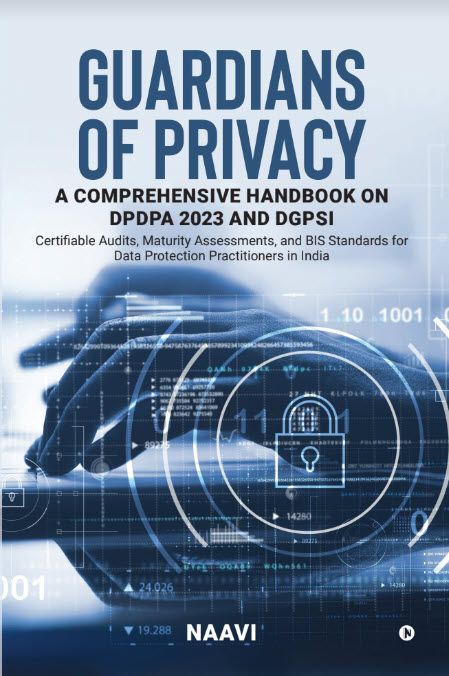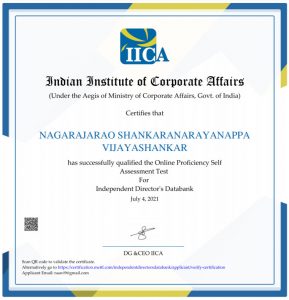The Government of India has announced a draft National Encryption Policy as an adjunct to the requirements under Section 84A of ITA 2008 which required a notification on the approved modes and methods and for encryption for use in e-Governance and e-Commerce.
The policy acknowledges that the meanings attached to different methods of encryption namely hashing, symmetric encryption and asymmetric encryption has already been explained under ITA 2000. The modes of encryption to be used and the algorithms with respect to hashing and asymmetric encryption used in digital signatures also has been already prescribed under ITA 2000 by CCA.
What ITA 2000/8 had not done was to suggest what algorithms are considered approved for symmetric encryption if used either in the SSL systems or for encryption of data in storage.
Now the draft notification indicates that AES, Triple DES and RC4 encryption algorithms and key sizes upto 256 bits are to be used. We may however note that the RSA keys used for asymmetric encryption as per CCA guidelines indicate key sizes of 2048 and 4096 bit (Ref notification GSR 783(E) dated 25th october 2011 read along with earlier notifications).
(For non technologists, it is always difficult to understand the difference in the key length and encryption bit length and the difference in symmetric and asymmetric key strengths. . In RSA, the bit length is indicative of the size of the integer used in the mathematical model where as in the symmetric key system the bit length just indicates the number of bits in the key. Technologists say that 2048 bit RSA key length is equivalent to 256 bit key strength in Symmetric encryption from the point of view of breaking through brute force.)
The National Encryption Policy (NEP) goes much beyond the Section 84A requirements and the draft as provided for public comments may have impact on the larger public and hence it needs a discussion at some length.
Applicability:
- The Draft National Encryption Policy (D-NEP) is applicable to all Central and State Government Departments (including sensitive Departments / Agencies while performing nonstrategic & non-operational role), all statutory organizations, executive bodies, business and commercial establishments, including public sector undertakings and academic institutions and all citizens (including Personnel of Government / Business performing non-official / personal functions). (See Suggestion 1 below)
- It is not applicable to sensitive departments / agencies of the government designated for performing sensitive and strategic roles.
Classification:
Based on the nature of transactions that require encryption the users in the Policy are classified as:
(i) Govt. – All Central and State Government Departments (including sensitive departments / agencies while performing non-strategic and non-operational role).
(ii) All statutory organizations, executive bodies, business and commercial
establishments, including all Public Sector Undertakings, Academic institutions.
(iii) All citizens (including personnel of Government / Business (G/B) performing nonofficial / personal functions).
(iv) G2G Government to Government users
(v) G2B, G2C, B2G & C2G Government to Business & Government to Citizen users
(vi) B2B Business to Business users
(vii) B2C & C2B Business to Citizen users
The Regulation
(1) Use of Encryption technology for storage and communication within G group of users with protocols & algorithms for Encryption, key exchange, Digital Signature and hashing will be as specified through notification by the Government from time to time.
(2). Use of Encryption technology for communications between G group and B / C groups (i.e. G2B and G2C sectors) with protocols and algorithms for encryption, key exchange, Digital Signature and hashing will be as specified through notification by the Government from time to time.
(3) Users / Organizations within B group (i.e. B2B Sector) may use Encryption for storage and communication.
Encryption algorithms and key sizes shall be prescribed by the Government through Notifications from time to time.
On demand, the user shall be able to reproduce the same Plain text and encrypted text pairs using the software / hardware used to produce the encrypted text from the given plain text. (See Suggestion 2 below)
Such plain text information shall be stored by the user/organisation/agency for 90 days from the date of transaction and made available to Law Enforcement Agencies as and when demanded in line with the provisions of the laws of the country. (See Suggestion 3 below)
(4) B / C groups (i.e. B2C, C2B Sectors) may use Encryption for storage and communication.
Encryption algorithms and key sizes will be prescribed by the Government through Notification from time to time.
On demand, the user shall reproduce the same Plain text and encrypted text pairs using the software / hardware used to produce the encrypted text from the given plain text.
All information shall be stored by the concerned B / C entity for 90 days from the date of transaction and made available to Law Enforcement Agencies as and when demanded in line with the provisions of the laws of the country.
In case of communication with foreign entity, the primary responsibility of providing readable plain text along with the corresponding Encrypted information shall rest on entity (B or C) located in India. (See Suggestion 4 below)
(5) Service Providers located within and outside India, using Encryption technology for providing any type of services in India must enter into an agreement with the Government for providing such services in India.
Government will designate an appropriate agency for entering into such an agreement with the Service provider located within and outside India. The users of any group G,B or C taking such services from Service Providers . are also responsible to provide plain text when demanded. (See Suggestion 5 below)
(6) Users within C group (i.e. C2C Sector) may use Encryption for storage and communication.
Encryption algorithms and key sizes will be prescribed by the Government through Notification from time to time.
All citizens (C), including personnel of Government / Business (G/B) performing non-official / personal functions, are required to store the plaintexts of the corresponding encrypted information for 90 days from the date of transaction and provide the verifiable Plain Text to Law and Enforcement Agencies as and when required as per the provision of the laws of the country. (Suggestion 1 already covers this point)
(7) Algorithms and key sizes for Encryption as notified under the provisions in this Policy only will be used by all categories of users
Regulatory Framework:
(a) All vendors of encryption products need to be pre registered with the Government of India.
(b)List of Registered vendors would be published by the Government. Users in India would be required to use only products registered in India.
(c) Export of Encryption products would be permitted with prior intimation to the designated agency of the Government of India.
Additionally, the Government has through this policy expressed its intention to support research in encryption and also set up a testing and evaluation infrastructure. A Technical advisory committee will take the responsibility of advising the Government on review of the policy from time to time.
While some of the follow up would be through the notification under Section 84A, the present draft does not contain the information on some of the aspects such as the agency for registration etc. Some more follow up guidelines will therefore be required.
In the meantime, members of the public may send their responses to the Government by 16/10/2015 to Shri A. S. A. Krishnan, Scientist ‘G’, Department of Electronics and Information Technology, Electronics Niketan, 6, CGO Complex, Lodhi Road, New Delhi: 110003, Email: akrishnan@deity.gov.in
Naavi has some specific observations that are listed below. If the readers have any comments and additional points, they can send them to naavi for consolidation before they are forwarded to the department.
Even if readers donot have any additional observations, I request the readers to send two suggestions namely to keep the common citizens out of the policy responsibilities and for the Government to conduct a free encryption education certification program for those who are interested. The suggestion maybe sent by email to the email address akrishnan@deity.gov.in directly before 16th October 2015.
Naavi’s Observations/Suggestions
Suggestion 1:
The NEP is made applicable to all organizations except sensitive departments of the Government. It is presumed that the sensitive departments to whom the policy is not applicable may use more stringent encryption norms. What is however notable is that the policy is applicable to common citizens.
Government must take note that the knowledge and expertise of common citizens may be inadequate to understand the nuances of encryption.
Though the Citizens will be indirectly impacted by the policy as implemented by the Government or Business users, Citizens cannot at this point of time assume the responsibility for direct compliance of this policy since their ignorance would be exploited by intermediaries for business gain.
For example, if a Citizen uses a service available on the internet which uses say a higher level of encryption than what is approved then this policy may make him liable for the violation. User may not even know what encryption is being used within a software or service that he may buy and whether that product is “NEP-compliant” The service provider himself may be outside the jurisdiction and hence escape liability including the responsibility for registration.
Already Netizens in India are being pushed to the use of technology without apropriate security cover nor Cyber Insurance cover and the encryption policy will introduce one more risk and possible liability for the honest citizen.
If the Government wants to make common citizens responsible for knowing the encryption policy, how it is operated in practice and how it affects them, there has to be a large scale education program.
Government should provide a “Free Encryption Education Certification” program to all interested Netizens.
There is also a need to clarify in common man’s terms what the “Strength of Encryption means” and how it differs from Symmetric and Asymmetric systems, Difference between Cipher Block Sizes and Key lengths etc.in the policy document.
Further, keeping in view the inconsistent use of terms by technologists, the Government should push through Cyber Insurance for individuals so that any liabilities arising out of inconsistent technical interpretations about the “Strength” of encryption is covered by insurance.
Suggestion 2:
Most of the intermediaries who provide services to Netizens store passwords of the Netizen users in hash form. Some technologists consider that hashing is also a method of encryption (though the draft notification under Sec 84A has not included hashing as a method of encryption.). If hashing is considered as encryption, reversing the process is not feasible.
Hence an explanation may be required to state that “hashing” is not considered “Encryption” for the purpose of this policy and Section 84A
Suggestion 3:
The need to preserve plain text information such as passwords for 90 days provides a wrong impression that Sensitive Personal Information as defined by section 43A of ITA 2008 has to be stored in an insecure manner as per this guideline.
It will also cause confusion as regards retention of data which the law enforcement may require when the data custodian is aware that the information constitutes an “Evidence” under law. There will be conflict with Section 65 of ITA 2008 also in such cases.
The wordings of the policy need to therefore be changed.
Suggestion 4:
The provision to exempt a foreign entity from the responsibility to provide unencrypted information interferes with the right of the law enforcement to conduct investigation in criminal cases where the foreign entity may refuse to part with unencrypted information from their end. This provision can be deleted.
Suggestion 5:
The provision to require service providers using encryption technology to register and enter into an agreement with a body of the Government of India is redundant and unenforceable as a part of this policy. Since there is a large number of services today which use encryption (even accepting the fact that SSL/TLS users are exempted), this policy may require thousands of websites to enter into agreement with the Government. Already there is a provision in Section 69 of ITA 2008 which is a statutory law. Hence this provision for entering into a contract should be deleted.
Naavi
Ref: Copy of the Draft National Encryption Policy






